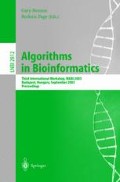Abstract
The reconstruction of evolutionary trees is a major problem in biology, and many evolutionary trees are estimated using heuristics for the NP-hard optimization problem Maximum Parsimony. The current heuristics for searching through tree space use a particular technique, called “tree-bisection and reconnection”, or TBR, to transform one tree into another tree; other less-frequently used transformations, such as SPR and NNI, are special cases of TBR. In this paper, we describe a new tree-rearrangement operation which we call the p-ECR move, for p-Edge-Contract-and-Refine. Our results include an efficient algorithm for computing the best 2-ECR neighbors of a given tree, based upon a simple data structure which also allows us to efficiently calculate the best neighbors under NNI, SPR, and TBR operations (as well as efficiently running the greedy sequence addition technique for maximum parsimony). More significantly, we show that the 2-ECR neighborhood of a given tree is incomparable to the neighborhood defined by TBR, and properly contains all trees within two NNI moves. Hence, the use of the 2-ECR move, in conjunction with TBR and/or NNI moves, may be a more effective technique for exploring tree space than TBR alone.
Access this chapter
Tax calculation will be finalised at checkout
Purchases are for personal use only
Preview
Unable to display preview. Download preview PDF.
References
Allen, B., Steel, M.: Subtree Transfer Operations and their Induced Metrics on Evolutionary Trees. Annals of Combinatorics 5, 1–15 (2001)
Bonet, M., Steel, M., Warnow, T., Yooseph, S.: Better Methods for Solving Parsimony and Compatibility. Journal of Computational Biology 5(3), 409–422 (1998)
Buneman, P.: The Recovery of Trees from Measures of Dissimilarity. Mathematics in the Archaelogical and Historical Sciences, pp. 387–395 (1971)
Dasgupta, B., He, X., Jiang, T., Li, M., Tromp, J., Zhang, L.: On the Distances Between Phylogenetic Trees. In: Proceedings of the 8th Annual ACM-SIAM Symposium on Discrete Algorithms, pp. 427–436. ACM-SIAM (1997)
Foulds, L.R., Graham, R.L.: The Steiner problem in Phylogeny is NP-complete. Advances in Applied Mathematics 3, 43–49 (1982)
Fitch, W.: Toward Defining Course of Evolution: Minimum Change for a Specified Tree Topology. Systematic Zoology 20, 406–416 (1971)
Goloboff, P.A.: Character Optimization and Calculation of Tree Lengths. Cladistics 9, 433–436 (1994)
Goloboff, P.A.: Methods for Faster Parsimony Analysis. Cladistics 12, 199–220 (1996)
Goloboff, P.A.: Analyzing Large Datasets in Reasonable Times: Solutions for Composite Optima. Cladistics 15, 415–428 (1999)
Hein, J., Jiang, T., Wang, L., Zhang, K.: On the Complexity of Comparing Evolutionary trees. Discrete Applied Mathematics 71, 153–169 (1996)
Li, M., Tromp, J., Zhang, L.: On the Nearest Neighbour Interchange Distance Between Evolutionary Trees. Journal of Theoretical Biology 182, 463–467 (1996)
Maddison, D.R.: The Discovery and Importance of Multiple Islands of Most Parsimonious Trees. Systematic Zoology 43(3), 315–328 (1991)
Robinson, D.F., Foulds, L.R.: Comparison of Phylogenetic Trees. Mathematical Biosciences 53, 131–147 (1981)
Robinson, D.F.: Comparison of Labeled Trees with Valency Three. Journal of Combinatorial Theory 11, 105–119 (1971)
Swofford, D., Olson, G.J., Waddell, P.J., Hillis, D.M.: Molecular Systematics, 2nd edn. ch. Phylogenetic Inference, pp. 407–425. Sinauer Associates, Sunderland (1996)
Swofford, D.L.: Studies in Numerical Cladistics: Phylogentic Inference Under the Principle of Maximum Parsimony. PhD thesis, University of Illinois at Urbana-Champaign (1986)
Warnow, T.: Tree Compatibility and Inferring Evolutionary History. Journal of Algorithms 16, 388–407 (1994)
Author information
Authors and Affiliations
Editor information
Editors and Affiliations
Rights and permissions
Copyright information
© 2003 Springer-Verlag Berlin Heidelberg
About this paper
Cite this paper
Ganapathy, G., Ramachandran, V., Warnow, T. (2003). Better Hill-Climbing Searches for Parsimony. In: Benson, G., Page, R.D.M. (eds) Algorithms in Bioinformatics. WABI 2003. Lecture Notes in Computer Science(), vol 2812. Springer, Berlin, Heidelberg. https://doi.org/10.1007/978-3-540-39763-2_19
Download citation
DOI: https://doi.org/10.1007/978-3-540-39763-2_19
Publisher Name: Springer, Berlin, Heidelberg
Print ISBN: 978-3-540-20076-5
Online ISBN: 978-3-540-39763-2
eBook Packages: Springer Book Archive

